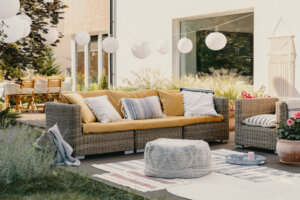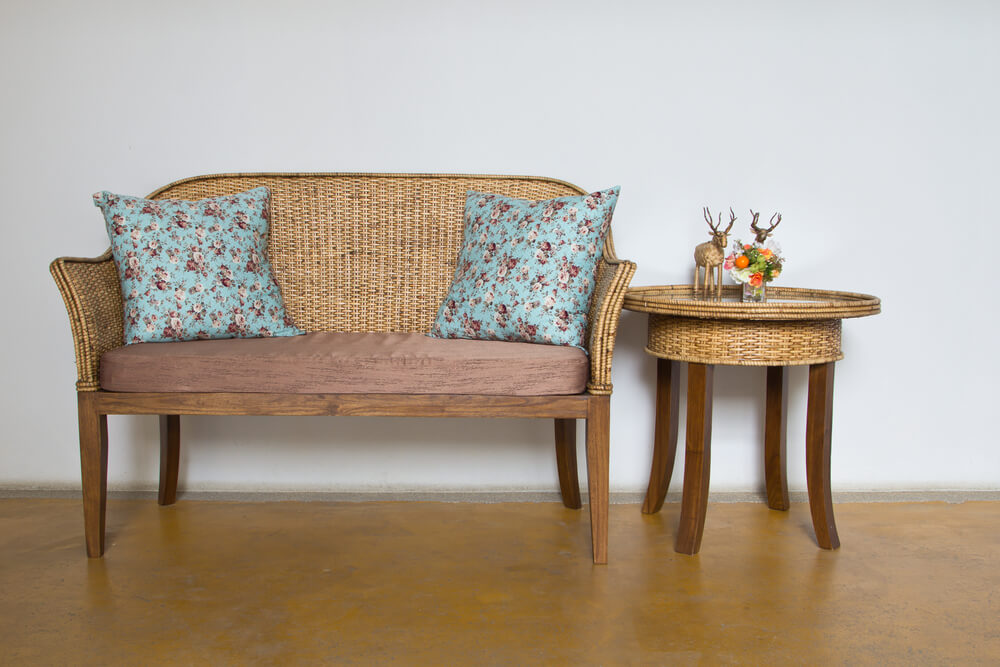Traditional Armchairs Made of Rattan

Generally, we expect decorative products and furniture are made to a certain quality. As consumers, we expect durability and for our furniture to stand the test of time. Hence, today, we want to know more about traditional rattan armchairs.
This material is being used more frequently because of its appearance and quality. Our objective is to discover how durable rattan is and how well it complements other home furnishings.
As a general rule, when we consider armchairs, we tend to focus on those that are made of wood or foam. However, there are other interesting options available in rattan that can provide the quality we desire. Basically, is rattan where we should invest our money?
What is rattan?

We can note two different types of rattan. On the one hand, there’s a natural type, originating from climbing plants that develop in hot and tropical climates. However, the natural rattan has one weakness: the weather. If there’s too much humidity or it’s used outside in adverse weather conditions, natural rattan can be severely affected.
On the other hand, there’s synthetic rattan. This is probably the most common type. It’s manufactured from synthetic fibers that try to simulate the appearance of natural rattan. Unlike the natural type, this can withstand different and adverse weather conditions.
Regarding decoration, what can rattan bring us? There’s no doubt that its aesthetics are attractive. It presents a natural and solid image, as well as elegance and sophistication, depending on the finish it has. Moreover, most rattan armchairs fit well and complement any space.
What are traditional rattan armchairs like?
Now we understand a little more about rattan, we should pay attention to the armchair itself: what is it like, what does it look like and how does it work in interiors? There’s a wide variety of choices available, it’s just a matter of finding the ideal option that works for you.
- The latticework of the rattan can be more or less open. In other words, the armchair can have either minimal decorative spaces or interlaced fibers that predominate the look to a greater extent.
- It should be noted that most rattan armchairs fall into a vintage category. This is mainly due to the feeling of antiquity as if it came from another era.
- On the contrary, there are also more contemporary designs where the seat pad has simple lines. Don’t forget that the latest trends in interior design are more functional.
- Regarding the size, armchairs aren’t usually too tall. However, they can span quite a bit in width. This guarantees us greater comfort and stability.
- Some armchairs are made entirely of rattan and others may incorporate additional materials such as metal legs. This contrast guarantees resistance and firmness, and they also fit very well in contemporary decorative styles.
Traditional armchairs for terraces

We all like to enjoy a warm evening sitting on the terrace in summer. To turn this area into a place of comfort and tranquility, it’s important that this type of seating is aesthetically pleasing.
In this sense, we can use rattan to turn the terrace into a calm and sophisticated space, worthy of spending quality time with family and friends. In addition, it’s a way of surprising and delighting your visitors.
Rattan provides a warm look and complements almost any space.
Decoration for country houses
Traditional rattan armchairs fit very well in country settings. For example, rural houses often have a nostalgic and authentic atmosphere, perfectly complemented by rattan. In this way, we can also link interiors with the exteriors by using armchairs that may appear to be natural rattan but are actually synthetic.
In short, rattan armchairs are very useful to create a stunning decorative space, with a look that’s both contemporary and traditional.
Generally, we expect decorative products and furniture are made to a certain quality. As consumers, we expect durability and for our furniture to stand the test of time. Hence, today, we want to know more about traditional rattan armchairs.
This material is being used more frequently because of its appearance and quality. Our objective is to discover how durable rattan is and how well it complements other home furnishings.
As a general rule, when we consider armchairs, we tend to focus on those that are made of wood or foam. However, there are other interesting options available in rattan that can provide the quality we desire. Basically, is rattan where we should invest our money?
What is rattan?

We can note two different types of rattan. On the one hand, there’s a natural type, originating from climbing plants that develop in hot and tropical climates. However, the natural rattan has one weakness: the weather. If there’s too much humidity or it’s used outside in adverse weather conditions, natural rattan can be severely affected.
On the other hand, there’s synthetic rattan. This is probably the most common type. It’s manufactured from synthetic fibers that try to simulate the appearance of natural rattan. Unlike the natural type, this can withstand different and adverse weather conditions.
Regarding decoration, what can rattan bring us? There’s no doubt that its aesthetics are attractive. It presents a natural and solid image, as well as elegance and sophistication, depending on the finish it has. Moreover, most rattan armchairs fit well and complement any space.
What are traditional rattan armchairs like?
Now we understand a little more about rattan, we should pay attention to the armchair itself: what is it like, what does it look like and how does it work in interiors? There’s a wide variety of choices available, it’s just a matter of finding the ideal option that works for you.
- The latticework of the rattan can be more or less open. In other words, the armchair can have either minimal decorative spaces or interlaced fibers that predominate the look to a greater extent.
- It should be noted that most rattan armchairs fall into a vintage category. This is mainly due to the feeling of antiquity as if it came from another era.
- On the contrary, there are also more contemporary designs where the seat pad has simple lines. Don’t forget that the latest trends in interior design are more functional.
- Regarding the size, armchairs aren’t usually too tall. However, they can span quite a bit in width. This guarantees us greater comfort and stability.
- Some armchairs are made entirely of rattan and others may incorporate additional materials such as metal legs. This contrast guarantees resistance and firmness, and they also fit very well in contemporary decorative styles.
Traditional armchairs for terraces

We all like to enjoy a warm evening sitting on the terrace in summer. To turn this area into a place of comfort and tranquility, it’s important that this type of seating is aesthetically pleasing.
In this sense, we can use rattan to turn the terrace into a calm and sophisticated space, worthy of spending quality time with family and friends. In addition, it’s a way of surprising and delighting your visitors.
Rattan provides a warm look and complements almost any space.
Decoration for country houses
Traditional rattan armchairs fit very well in country settings. For example, rural houses often have a nostalgic and authentic atmosphere, perfectly complemented by rattan. In this way, we can also link interiors with the exteriors by using armchairs that may appear to be natural rattan but are actually synthetic.
In short, rattan armchairs are very useful to create a stunning decorative space, with a look that’s both contemporary and traditional.
All cited sources were thoroughly reviewed by our team to ensure their quality, reliability, currency, and validity. The bibliography of this article was considered reliable and of academic or scientific accuracy.
- Stevens, David: Una habitación exterior, Blume, 2008.







